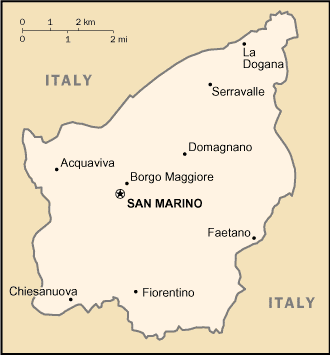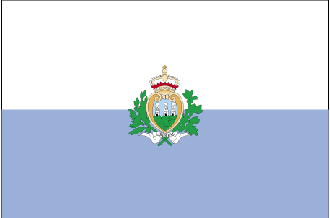
|
San Marino
Background:
The third smallest state in Europe (after the Holy See and Monaco) also claims
to be the world's oldest republic. According to tradition, it was founded by a
Christian stonemason named Marinus in 301 A.D. San Marino's foreign policy is
aligned with that of Italy. Social and political trends in the republic also
track closely with those of its larger neighbor.
Location:
Location: Southern Europe, an enclave in central Italy.
Area: Total: 61.2 sq km.
Area - comparative: About 0.3 times the size of Washington, DC.
Land boundaries: Total: 39 km, border countries: Italy 39 km.
Climate and Terrain:
Climate: Mediterranean; mild to cool winters; warm, sunny summers.
Terrain: Rugged mountains.
Natural resources: Building stone.
Geography - note: Landlocked; smallest independent state in Europe after the
Holy See and Monaco; dominated by the Apennines.
People:
Population: 28,119.
Ethnic groups: Sammarinese, Italian.
Religions: Roman Catholic.
Languages: Italian.
Government:
Government type: Independent republic.
Capital: San Marino.
Independence: 3 September 301.
Economy overview:
The tourist sector contributes over 50% of GDP. In 2000 more than 3 million
tourists visited San Marino. The key industries are banking, wearing apparel,
electronics, and ceramics. Main agricultural products are wine and cheeses. The
per capita level of output and standard of living are comparable to those of
the most prosperous regions of Italy, which supplies much of its food.
Agriculture - products: Wheat, grapes, corn, olives; cattle, pigs, horses,
beef, cheese, hides.
Statistics:
Telephones - main lines in use: 18,000.
Telephones - mobile cellular: 3,010.
Radio broadcast stations: AM 0, FM 3.
Radios: 16,000.
Television broadcast stations: 1 (San Marino residents also receive broadcasts
from Italy).
Televisions: 9,000.
Highways: Total: 220 km paved.
Return to Visiting Locations
|

